|
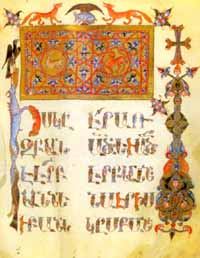
First
Page of the Gospel of St. John, The Gospels
1270ís, Cilicia
Exact origin, names of scribe and illuminator unknown
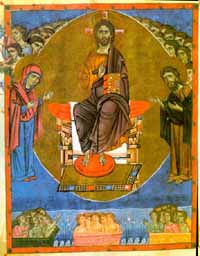
The last Judgement,
The Gospels
1268, Hromkla monastery, Cilicia
Written and illuminated by Toros Roslin
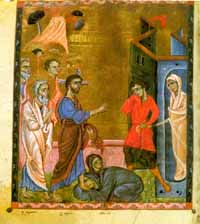
The
Raising of Lazarus, The Gospels
1268, Hromkla monastery, Cilicia
Written and illuminated by Toros Roslin
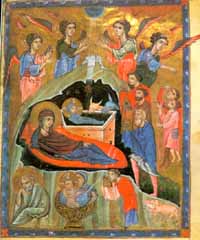
The
Nativity, The Gospels
1268, Hromkla monastery, Cilicia
Written and illuminated by Toros Roslin
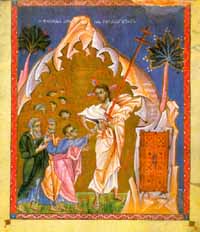
The
Incredulity of Thomas, The Gospels
1268, Hromkla monastery, Cilicia
Written and illuminated by Toros Roslin
|
The
cultural life of Armenia, which had to a certain extent slowed
down at the turn of the eleventh century, in the course of the
next two hundred years underwent a revival not only on Armenian
territory proper but also in some regions outside the country,
which were then receiving Armenian immigrants. Cilicia occupied
a prominent position among these regions.
Cilicia was a small
mountainous country on the Northeast coast of the Mediterranean.
It must have strongly reminded the exiles of their homeland,
and the first Armenian settlements had already appeared in Cilicia
during the rule of Tigran the Great (97-86 BC).
Towards
the end of the eleventh century various regions and cities of
Cilicia united into a principality under the Roubenids - a dynasty
founded by former vassals of the Armenian king Gagik Bagratuni,
who moved to Cilicia where they owned a castle in the Taurus
mountains, near the so-called Cilician Gates (a passageway in
the mountains). A century later, under Leon II, the principality
was transformed into a kingdom which lasted for almost two hundred
years - up to the end of the fourteenth century - and for the
whole of this time remained one of the most influential states
of the Middle East.
The portrait
from a manuscript commissioned by the Catolicos Constantine
I as a gift for his godson, Prince Leon, heir to the throne
and the future King Leon III, is one of the earliest surviving
examples of Cilician portrait painting. In accordance with the
medieval tradition, the representation is devoid of any individual
portrait characteristics. The artist was apparently perplexed
by the unusual task, and his considerable gift as a miniature
painter could reveal itself to the full only in the treatment
of the Prince's magnificent garments and in the rich and varied
colouring.
This does
not mean, however, that in Cilicia only the upper classes had
access to illuminated manuscripts. It is quite probable that
these more precious manuscripts were preserved with the utmost
care and were the first to be rescued by the Cilicians who,
at the fall of the kingdom, were obliged to leave the country.
Despite
the overall stylistic uniformity of Cilician miniature painting,
there were several schools that possessed certain features typical
of their school. The most prominent centres of art and writing
were the monasteries. The most famous were Hromkla (a fortress
on the Euphrates which served as the residence of the Catolicos,
head of the Armenian Church), Drazark, Akhner and Gríner, situated
near the city of Sis and associated with the royal family and,
finally, Skevra which belonged to the domain of the Oshinids,
the most influential and enlightened of all Cilician princely
houses.
Cilician
book painting reached its peak between 1250 and 1290. Its magnificent
achievements were rooted in the preceding development of miniature
art over one and a half centuries. The distinctive style of
Cilician miniature began to take shape towards the end of the
twelfth century; it is only natural, therefore, that its characteristic
traits are discernible in works dating from the beginning and
first half of the thirteenth century.
The mature
Cilician style is represented in the Matenadaran by two manuscripts,
of 1249 (Ms. 7690) and 1251 (Ms. 3033). Both were produced at
the Hromkla monastery. This sample from the 1251 Gospels shows
a more natural effect, with the drapery revealing the contours
of the body, and the posture lifelike. The rich colouring is
based on saturated blue, green and red hues set off by gold,
and the ornament is minutely elaborated.
The 1249
Gospels was illuminated by Kirakos, one of the leading Hromkla
masters, whose work is represented in the Matenadaran by several
manuscripts dating from the 1240s. Kirakos was an immediate
predecessor, an older contemporary and, in all probability,
the teacher of one of the greatest Armenian artists - Toros
Roslin.
|
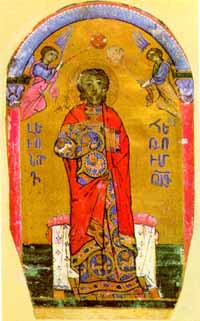
Portrait
of Prince Leon, The Gospels
13th century, Hromkla monastery, Cilicia
Names of scribe and illuminator unknown
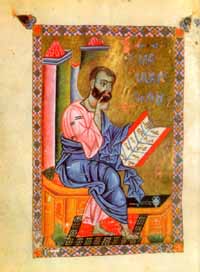
St.
Mark
The Gospels
1251, Hromkla monastery, Cilicia
Written by Sarkis, name of illuminator unknown
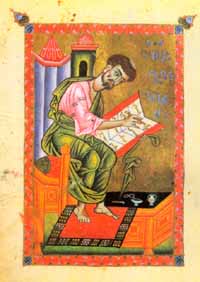
St.
Luke, The Gospels
1251, Hromkla monastery, Cilicia
Written by Sarkis, name of illuminator unknown
|

